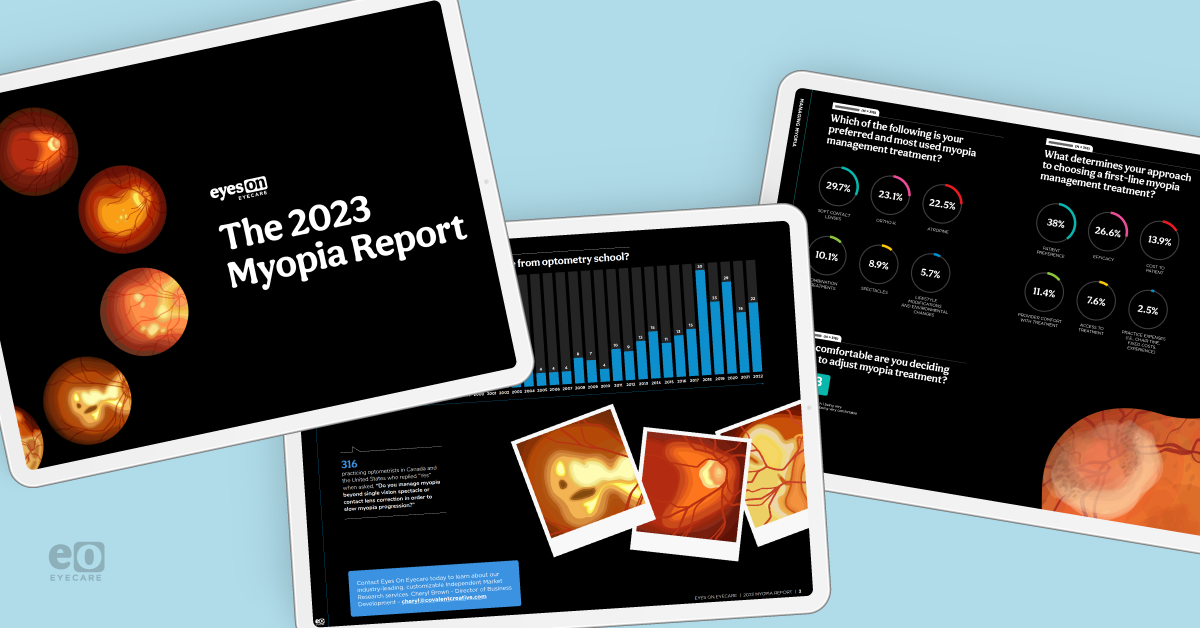Myopia is the most common ocular disease, affecting an estimated 20% of the global population. Myopia management—defined here as therapeutic interventions designed to slow or even potentially halt the progression of myopia—has become a hot topic in the last decade.
In March 2023, Eyes On Eyecare surveyed 316 qualified respondents—optometrists who manage myopia beyond single vision spectacle or contact lens correction in order to slow progression—in the US and Canada to learn more about how the optometric community defines and approaches “
myopia management.”
In this first annual Eyes On Eyecare Myopia Report, we present to you the results of this survey! As with all of our reports, the data is absolutely free to access.
Download the 2023 Myopia Report now, or keep reading for a sneak peek at the findings!
📝
The 2023 Myopia Report
Discover how fellow optometrists monitor and manage myopia, oversee specialty clinics, and educate patients on treatment options.
The 2023 Myopia Report covers:
- Confidence in diagnosis and management: How comfortable are optometrists with diagnosing and managing myopia?
- Technologies for screening: What are the most common diagnostic methods used by optometrists to identify and track myopia progression?
- Management techniques to slow myopia progression: How do ODs classify their approach to myopia management? What level of progression warrants intervention? What management techniques are most popular?
- Practice management: How do ODs feel myopia management has impacted their practice?
- And more!
Optometrists remain split on the importance of monitoring axial length
Respondents were nearly evenly split on the importance of monitoring axial length in their myopic patients, and even those who believed that axial length should be monitored in every patient with myopia did not always do so.
However, there is growing evidence that axial length can serve as an early warning sign of myopic progression.
1 Many optometrists, at this point, view axial length not just as a crucial metric for tracking
myopia progression but also as an invaluable tool for educating parents, guardians, and patients.
Managing myopia starts early
At
68%, a majority of respondents felt that low myopia (classified as -0.25D to -2.00D) was the baseline of myopia that warrants the implementation of
myopia management.
However, respondents were more split about the amount of progression that would warrant the implementation of the same, with 39% leaning towards 0.50D, 27% leaning towards 0.75D, and the rest divided.
Even so, it’s clear that optometrists are proactive about their approach to myopia management.
Optometrists want more education on myopia management—especially orthokeratology
Of respondents,
35.8% identified
orthokeratology (ortho-k) as the myopia management technique that they most wished they had more education on, outstripping combination treatments (
28.8%) and atropine (
12.7%). This is unsurprising since ortho-k was also the myopia management technique that respondents felt the least confident in.
It’s good to see that optometrists’ confidence in the quality of education on myopia management in
optometry schools has consistently improved over the last decade, with average confidence ratings almost doubling since 2012. In order to provide quality care to our current and future patients, it will be increasingly crucial for optometrists to excel in this modality as the prevalence of myopia grows worldwide.
Myopia management outcomes and opportunities
The Joint WHO-Brien Holden Vision Institute (BHVI) Report from 2015, The Impact of Myopia and High Myopia, suggests that by 2050 over 50% of the world’s population will be affected by this disease.
2 It’s the leading cause of
visual impairment in children, carrying with it a bevy of potential physiological risks and complications.
Optometrists are at the forefront of myopia management, and adding these options to your arsenal is an opportunity to benefit your patients and your practice!
